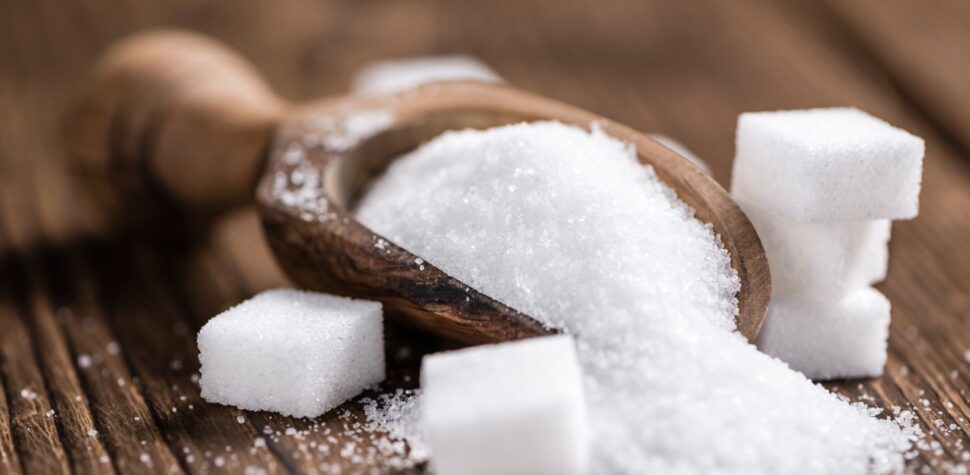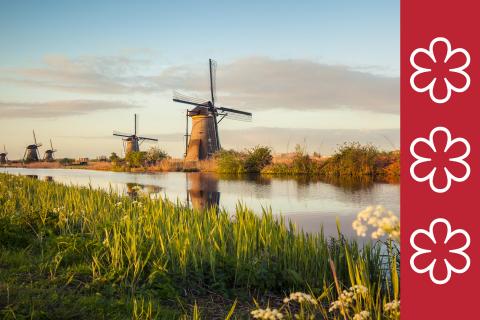Whenever we think of sugar, our minds immediately go to sweetness. And indeed, sugar sweetens baked goods, savoury dishes and drinks. But it also serves other purposes – it can enhance flavour and texture. It helps to make dough tender, keeps egg whites stable when making meringues and pavlovas, and gives baked goods a nice golden brown colour.
How well do you know the different types of sugar? Discover 10 types of sugar with their best uses, ranging from white to brown to demerara sugar.
White sugar
White sugar, also called granulated sugar or table sugar, is produced by refining sugar cane or sugar beets. A food processor juices the sugar cane or beets first, then boils the cane juice to evaporate the water. A centrifuge spins raw sugar at high speeds to remove the sticky brown syrup that coats the sugar crystals, known as molasses. Once the sugar has been refined, it’s put through a natural carbon filtration system to remove impurities and whiten the sugar granules. The result is chemically pure sucrose.
White sugar is used in many foods, such as baked goods that require rising, like meringues, mousses and soufflés. It is also used to sweeten beverages and savoury dishes. It’s important to note that not all granulated white sugar is vegan – some sugar producers use bone char to whiten their products. Vegans should look for unrefined sugar or organic sugar.
Types of white sugar
- Granulated sugar. Granulated sugar, also known as regular sugar or white sugar, is refined sugar that food processors whiten and grind into a size similar to table salt. It is commonly used in baking recipes.
- Superfine sugar. Sometimes referred to as caster sugar, superfine sugar is processed similarly to white table sugar, but the sugar refinery grinds superfine sugar into smaller particles than regular table sugar. Superfine sugar is frequently used in desserts such as meringue, mousse and whipped cream. It’s also popular for sweetening cold drinks, like iced tea or lemonade, because the fine crystals dissolve much faster than table sugar.
- Powdered sugar. Also known as confectioners’ sugar, powdered sugar consists of finely ground white sugar mixed with a small amount of cornstarch. Frosting, icing and cream-based desserts often contain it since it dissolves rapidly.
- Sugar cubes. These square sugar cubes are made of white sugar pressed into a cube shape. They’re typically used to sweeten hot drinks.
Brown sugar
Brown sugar is made from crystalline sucrose and molasses, which is responsible for its distinctive colour and flavour. It’s produced in major sugar-producing countries, including in the Caribbean, Brazil, Australia, Europe, South Africa and parts of the US.
Brown sugar provides a touch of extra flavour compared to granulated white sugar and is a common ingredient in baked goods because it provides a dark sweetness. Brown sugar and baked goods made with it retain moisture well because molasses absorbs water. It’s also used in cooking, including sauces, marinades and bacon. Brown sugar is also made into a sugar syrup, usually with spices, to flavour beverages.
Types of brown sugar
The amount of molasses mixed with white sugar determines the type of brown sugar produced:
- Light brown sugar. This type of sugar is commonly used for baking. Recipes that call for brown sugar without specifying light or dark require light brown sugar.
- Dark brown sugar. Dark brown sugar contains approximately 6.5% molasses by weight and is used to create rich flavours and colours.
Caster sugar
Caster sugar is granulated sugar that is fine in texture, between granulated and powdered sugar in coarseness. As the crystals are so fine, they dissolve much faster than granulated white sugar, making caster sugar ideal for baking cookies, cakes, cupcakes, muffins and meringues, and for syrups and cocktails. It’s rarely used raw. It’s not used for icing, frostings or buttercream. In the US, caster sugar is also known as superfine sugar, baker’s sugar, castor sugar or bar sugar.
Confectioners’ sugar
Also known as powdered sugar, confectioners’ sugar is granulated white sugar that has been ground into a fine powder. Powdered sugar is almost chalky in texture, whereas granulated sugar is sandy and coarse. Commercial powdered sugar is combined with cornstarch, which acts as an ‘anti-caking agent’, preventing large clumps from forming. Confectioners’ sugar quickly dissolves in liquid and is perfect for icing and frosting and for coating doughnuts, marshmallows and chocolate-covered cereal.
Cane sugar
Unlike granulated sugar, which is produced from sugarcane or sugar beets, cane sugar is produced exclusively from sugarcane. It is made by chopping up the sugar cane, squeezing out the juice, boiling the liquid to produce unrefined molasses, and then crystallising it. After the syrup has crystallised, it is spun in a centrifuge to separate the crystals from the molasses.
Types of cane sugar
There are three main types of cane sugars: unrefined, raw and refined. These sugars differ in how they are processed, and the processing itself is essentially a rinsing process to remove some, most or all of the molasses.
- Unrefined sugar. It includes products like muscovado. It’s dark, containing most of the molasses.
- Raw sugar. This type of cane sugar includes products like turbinado and demerara and is an intermediate stage whose crystals are medium to coarse and whose colour ranges from blonde to light brown. Raw sugar retains a small but still significant amount of molasses flavour.
- Refined sugar. It includes white granulated sugar, bakers’ sugar and confectioners’ sugar and is the purest form of sugar, without molasses or other impurities. It’s ground in various fine consistencies, each with a specific application.
Cane sugar is used in recipes such as cookies, cakes and other desserts. It’s water-soluble and melts when heated. Sugars of this type can also be used as a garnish, for example, to add crunch to muffin tops.
Muscovado sugar
Also known as Barbados sugar, muscovado sugar is unrefined cane sugar that contains natural molasses. There are dark and light varieties, and the texture is sticky, moist and sandy, with a rich, complex flavour and a toffee-like taste. Although muscovado sugar can be used as a substitute for brown sugar, its flavour is much stronger. It works its magic in barbecue sauces, marinades, savoury dishes, and in giving a caramel-like sweetness to your salad dressings. It is also commonly used to intensify the delicious flavour of brownies, chocolate cookies, gingerbread, cakes, oatmeal and ice cream. You can also stir it into hot coffee for a complex sweetness that complements the bitter taste.
Demerara sugar
Demerara sugar originated in the British colony of Demerara, now known as Guyana. It’s extracted from sugarcane and is minimally refined. It has large amber grains, a crunchy texture and a mild molasses flavour. You can use it to sweeten coffee or tea or as a topping on baked goods, like muffins, scones, cookies and cakes, or as a crunchy topper for desserts like crème brûlée.
Coconut sugar
Coconut sugar looks like brown sugar and has an unmistakeable caramel flavour. It is produced in Southeast Asia from the sap of coconut palms. Because it undergoes minimal processing, coconut sugar retains some natural vitamins and minerals, although you would need to eat large amounts (something not generally recommended with sugars!) to reap the benefits.
Turbinado sugar
Turbinado sugar is similar to demerara and is minimally processed to make it safe to consume. It has a blond colour, large crystals and a mild brown sugar flavour. Turbinado sugar has a subtle caramel taste and is often used to sweeten hot drinks or in baking. It also has a higher molasses content than other sugar varieties.
Liquid sugar
Liquid sugar is simply white granulated sugar that has been dissolved in water. It is primarily used in drinks or for other food products such as jams, marmalades, pickles and preserves. Liquid sugar can be made at home but may be a little cloudy – check to ensure all the grains of sugar have dissolved.
This article was updated on 3/04/2023.









